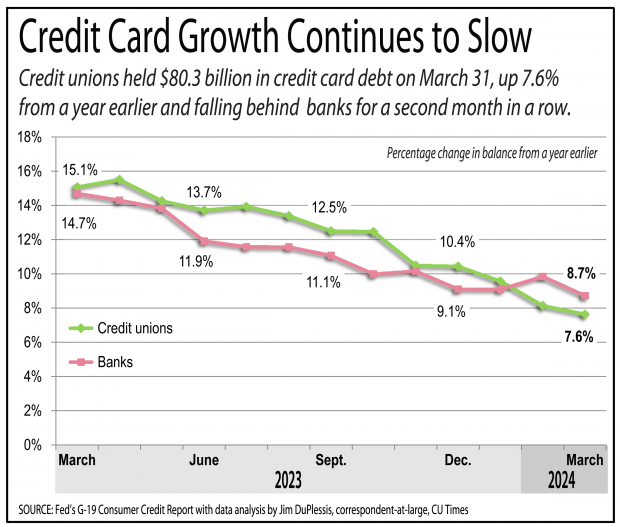
Credit unions continued to build balances with credit cards and consumer term loans even amid signs auto loan balances among all lenders have stalled since last September, according to a Fed report.
The Fed's Consumer Credit Report released Tuesday showed credit unions held $80.3 billion in credit card debt, up 7.6% from a year earlier. The balance fell 0.4% from February, compared with the 10-year average February-to-March drop of 0.1%. Balances typically fall in the first three months of the year as households pay down balances from holiday spending, often with the help of tax refunds.
Recommended For You
Credit unions' share of credit card debt was 6.3% in March, unchanged from a year earlier and February.
Banks' share grew slightly over the past year. It was 90.7% in March, unchanged from February but up from 90.3% in March 2023.
Banks held $1.2 trillion in credit card debt, up 8.7% from a year earlier. It fell 0.5% from February to March, compared with the 10-year average drop of 0.4%.
Credit unions performed better than banks with non-revolving loans — the Fed's category that includes car loans and personal term loans.
Credit unions held $577.9 billion in term loans in March, up 1.3% from a year earlier. It rose 0.2% from February to March, compared with the 10-year average gain of 0.3%.
Banks held $896.6 billion in non-revolving consumer loans in March, down 4.1% from a year earlier. It fell 0.9% from February to March, compared with the 10-year average gain of 0.2%.
All lenders held $1.56 trillion in car loans in March, up 2.6% from a year earlier. Auto loans rose just 0.1% from Dec. 31 to March 31, the smallest quarter-to-quarter gain since loan balances were essentially unchanged from December 2019 to March 2020, when COVID-19 was declared a pandemic.
The fourth and first quarters typically have the lowest quarterly gains, but the 0.1% gain for 2024's first quarter compared with the 10-year average of 0.8% for first-quarter gains.
Moreover, if you exclude March 2020, it was the worst for any quarter since December 2015, when total auto loan balances fell 2.6% from September 2015. The other weakest gain was 0.2% from September to December 2023.
The Fed reports on auto loans only with data for the end of quarters, and not by lender type.
Auto loans are a big part of total non-revolving balances, and by that measure banks had a bigger December-to-March drop than credit unions, while both performed well below their 10-year averages for the first quarter. From December to March, non-revolving balances fell 0.4% (average +2.1%) at credit unions and fell 1.0% (average +0.8%) at banks.
Among the Top 10 credit unions by assets, total car loans stood at $73.4 billion March 31, up 9.7% from a year earlier and up 0.3% from Dec. 31. Their balance from indirect lending was $23.2 billion, up 3.9% from a year earlier and down 0.7% from the fourth quarter.
A more complete picture of how credit unions are performing in the automotive market will emerge with the Monthly Credit Union Estimates report expected from America's Credit Unions later this week, and from Experian's State of the Automotive Finance Market Report later this month.
© 2025 ALM Global, LLC, All Rights Reserved. Request academic re-use from www.copyright.com. All other uses, submit a request to [email protected]. For more information visit Asset & Logo Licensing.






